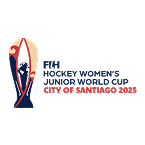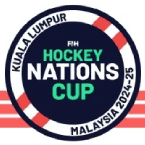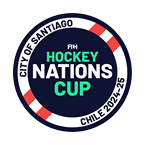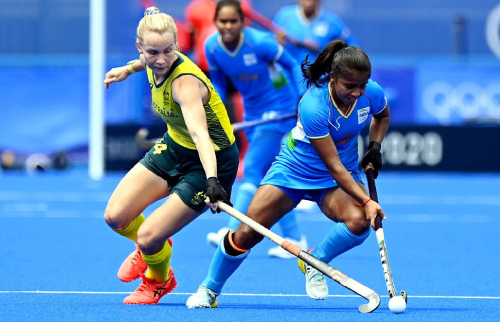
The FIH Academy hosted a webinar on hockey’s move towards dry (non-irrigated) turfs, introduced by FIH President Tayyab Ikram and led by Prof. Alastair Cox, the FIH Facilities and Quality Programme Manager, on 17 May, which was attended by over 150 participants, including members of National Associations, Continental Federations, hockey turf manufacturers and other stakeholders.
Hockey’s move towards dry turf is a response to the increasing scarcity of water resources around the world and the imperative to reduce the amount of water needed to play the sport. This move has been in progress since the 2018 FIH Congress where it was announced that the FIH would be working with the synthetic turf industry to develop synthetic turf surfaces that have the playing characteristics of wet turf, but do not require irrigation to achieve them.
The primary step was to research and determine the reasons wet turfs were preferred by athletes in the first place and make every effort to keep all those conditions consistent in the development of the dry turfs. The UK’s Loughborough University and specialist test institute, Labosport, assisted with this research, and a huge response was received from well over 200 international hockey players during the Olympic Games Tokyo 2020. Three primary areas were identified which were important for the athletes if they are to replicate their wet turf performance on a dry turf. These were:
- the way the ball reacts on the surface, including the speed, consistency and the bounce.
- the stick and surface interactions, including the glide, smoothness and the ability to initiate 3d skills.
- the player and surface interactions, including the rotational friction of the shoes, shock absorption and skin abrasion, and heat retention.
These three factors, along with the durability and environmental capability of the dry turfs, are being taken into consideration during the development phase of the dry turfs and have led to the introduction of the ‘Requirements for Dry (non-irrigated) Turfs’ as an addendum to the ‘Hockey Turf and Field Standards’ of the FIH. In addition, an Innovation category for turf group has been introduced by the FIH to encourage and enable innovative new dry turfs to be tested and certified as part of the FIH Quality Programme.
The planned roll out of the dry turfs is gradual and includes collecting constant feedback from athletes over the upcoming 2 years.
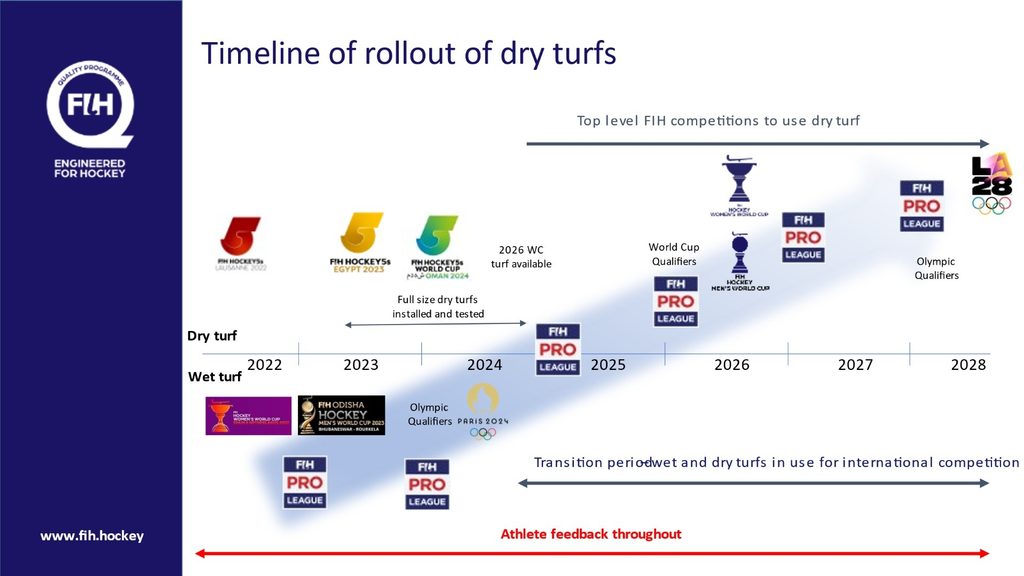
Dry turfs are currently being installed in various parts of the world, both full sized and smaller Hockey5s courts, and testing and athlete feedback on these turfs are important parts of the development process of the dry turfs that will be used in the future.
Within the 2023/24 period, more full sized dry turfs will be installed in clubs around the world and the inaugural FIH Hockey5s World Cup in Oman in January 2024 will also be played on a dry turf.
The transition of top tier international matches to dry turfs on a full scale will begin gradually after the Paris2024 Olympic Games (the last to be played on a wet, irrigated turf), with some FIH Hockey Pro League 2024/25 matches being played on dry turfs, where available, while some matches will also be played on wet turfs based on existing facilities.
From 2025 most top tier international matches will be moved to dry turfs, including the FIH Hockey Pro League 2025/26 season, the World Cup qualifiers in early 2026, and the FIH Hockey Women’s and Men’s World Cups 2026. This will continue, leading to the Olympic qualifiers and the Olympic Games Los Angeles 2028 which will all be played on dry turfs.
Speaking of the shift of hockey towards the dry turfs, FIH President Tayyab Ikram said: "At this exciting time for hockey, as the sport transitions to be played on turfs that no longer need to be watered to enable athletes to showcase their skills, speed and power, I was particularly pleased with the deep engagement of the global hockey community during this webinar, demonstrating the willingness to be an even more sustainable sport. This is really important in order to protect the planet and key to hockey’s development as well."


